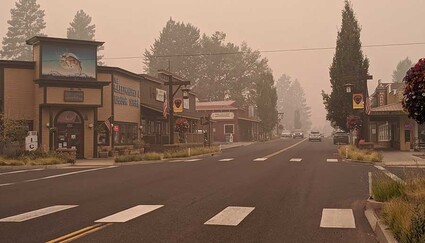Smoke created dire air quality locally
Last updated 9/16/2020 at Noon

Reecy Pontiff
Sisters had the worst air quality in the world at times during the past week, according to the Air Quality Index. Air quality was expected to improve through this week.
The hazardous air quality in Sisters — and much of the western U.S. — over the past week has been apparent from the permanent haze across town.
When the Air Quality Index (AQI) is rated as hazardous or unhealthy, “everybody should be staying indoors as much as possible” said Laura Gleim, spokesperson for the Oregon Department of Environmental Quality. “Folks that are at the most risk are people who are over 65, young children, and people with heart and lung conditions.”
Even people without preexisting conditions can feel the effects of wildfire smoke. Symptoms may include respiratory and sinus issues, headache, burning eyes, scratchy throat, increased heart rate and even fatigue, according to the Center for Disease Control (CDC).
A high-efficiency particulate air (HEPA) filter can help with indoor air quality, as can running air conditioning with the fresh-air intake closed, said the CDC. People who would normally let nature cool off their houses should keep windows and doors shut according to Gleim. A do-it-yourself box fan filter can be helpful, though she warns “you don’t want to put it in your window because then you’re bringing smoky air in from outside” (instructions in sidebar). Air quality tends to be worst in the evening.
“The primary pollutant of concern in any kind of wildfire smoke is very tiny particles that scientists call PM 2.5,” which is particulate matter smaller than 2.5 micrometers — that’s 30 times smaller than the width of a hair off your head,” said Gleim. “It’s very, very tiny and so when we inhale it it goes deep down into our lungs” and can cause inflammation, shortness of breath and coughing, as well as exacerbate heart and lung conditions.
“We’ve been trying to stress to people that cloth and paper masks that people have been wearing to prevent the spread of COVID-19 do not protect you from the harmful particles in wildfire smoke. Those particles are just too small and go right through that mask.”
Though heavy-duty N95 masks can be effective against ambient smoke inhalation, they come with their own challenges and may be in short supply due to use by frontline workers during the pandemic. Unlike their cloth counterparts, N95s can be problematic for people who already have breathing issues. Since they are designed to create a seal around the face, they should not be used by children or over facial hair. Also, N95s with a plastic vent will not contain the wearer’s germs from others, according the Food and Drug Administration.
“When we’re breathing air in our homes and our businesses that has high levels of these smoke particulates, I think the most important thing for your health is… eating well, drinking lots of water and upping your supplements,” said Jinny Reed, a retired assistant fire management officer with the Sisters Ranger District.
“Every individual has access to real-time data” on the internet, Reed said. She recommends people regularly check smoke outlooks and forecasts so they “can make informed decisions about what they’re going to do today, tomorrow, and sometimes in the future.” (Links to resources are available at the end of the story below.)
Currently “there is no clean air between Canada and Mexico in the Pacific states,” said Reed. “If you have a health condition, maybe… you need to go visit family far away and wait it out.”
A dramatic shift in the winds last week led to unusual easterly winds that blew wildfire smoke in the west away from Sisters but was part of the same windstorm that fueled the fires, according to Reed.
“It’s hard to pinpoint where smoke is coming from because we have a bunch of those big fires burning up and down the western side of the state,” said Gleim, who is based in Bend. The Lionshead fire around Mt. Jefferson and the enormous fires on the other side of the Cascades are likely the biggest contributors to the poor air quality in Sisters, Gleim said.
“Those fires in the uplands, they’re going to continue to burn and emit emissions until it rains or snows,” said Reed. “A season-ending event where it actually rains a quarter-inch or a half-inch doesn’t typically occur until [mid-to-late] October.”
“Your best line of defense is your personal health,” Reed said. “Do what you can to take care of yourself and stay informed.”
















Reader Comments(0)